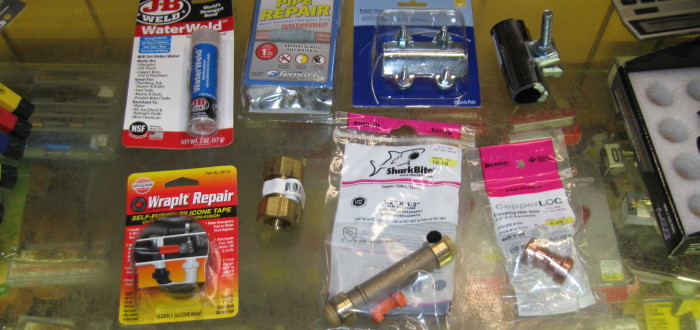Last week we covered “How to keep your pipes from freezing”, so this week we’ll talk about what to do if your pipes freeze anyway. So, how do you know if you’ve got frozen pipes? The first symptom is the most obvious, you turn on the tap and you have no water. You also might hear, as I did one night a few years ago the rushing sound of running water late at night when all are abed. You could also notice water dripping from the ceiling if you have plumbing overhead. It might seem counter-intuitive, but completely frozen pipes don’t leak. Unfortunately they also usually don’t stay frozen forever, and when they thaw, look out!
When the flood comes, or hopefully before, it’s good to know where your shutoff valves are located. They are usually in the basement ceiling somewhere, so take a flashlight and figure out where they are and what they control. If you are lucky you may be able to shut off the water to the affected area without cutting off the entire house. When you get the water off follow the pipe to the wet spot and try to see what the problem is. When water freezes it expands and this expandtion has enough force to burst a pipe wide open. It also sometimes forces soldered joints apart without actually breaking the pipe. Conversely, plastic pipe though not as strong as metal sometimes has enough give in it to survive being frozen and thawed without damage.
The first thing to do when you locate the trouble is to thaw out the pipe, getting warm air to it with a portable heater often works, but is slow. Rags soaked in hot water will thaw pipes quickly, as will a hot air gun, or in a pinch, a hair dryer. Try to resist using a plumber’s torch to thaw pipes, there is just too much danger of setting your house on fire. If you don’t believe me just watch the local news.
When you get the pipes thawed check them for damage, turn on the water slowly and have someone look for the telltale spray. If there appears to be no leak, you might have been lucky, but keep a lookout for hidden seepage. If you have an obvious leak access the size of the breach and you accessibility, which is often the critical factor. If you can’t get to the leak or can’t figure out how to fix it, you might have to call a plumber, but they are often backed up with calls during a cold snap. If you decide to tackle it yourself, there are several products that can work to get you water going again.
If the pipe has a simple split in it, and there is room to work on it, epoxy putty, fiberglass repair patches or the new miracle fusing tape may stop the leak. Carefully follow the directions on these and they sometimes work, but I would consider them all temporary repairs just until you can do the job right. If you have a simple split in copper or plastic tubing cutting it out and putting in a coupler is a better choice, a soldered repair in copper, or a glue joint in plastic is the conventional choice, but there are other choices that can work especially if you don’t consider yourself much of a plumber.
The other choices are either compression fittings that are tightened on the pipe with a wrench, or the newer push fittings that require no tools at all. Either of these are available in couplers or elbow fittings and can be used to put your pipes back together. As with all plumbing repairs, check carefully for leaks when you are finished, and be sure to re-do any temporary repairs when the weather gets better, Spring will be here before you know it. Well that’s it for today from the old hardware store.

